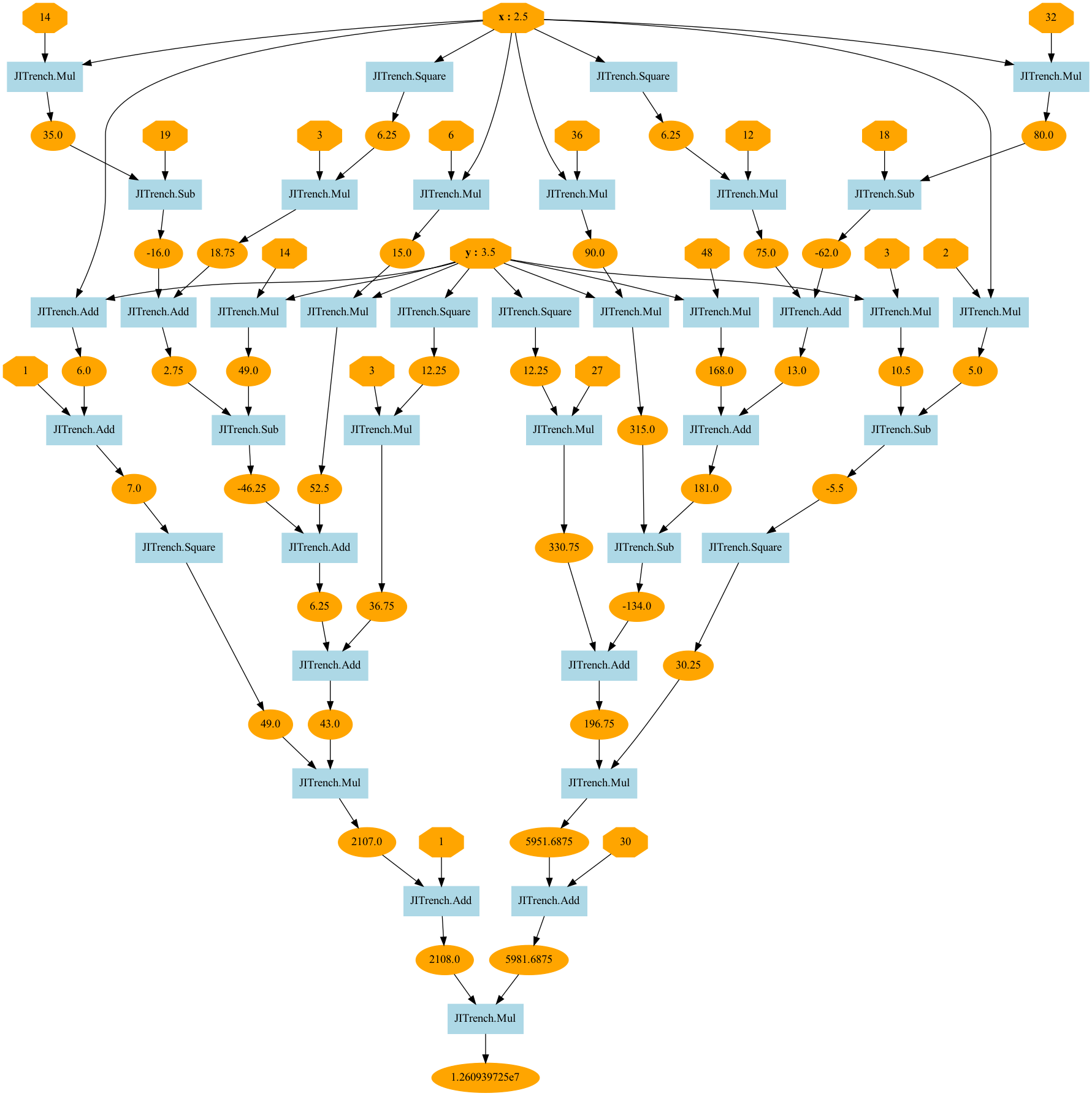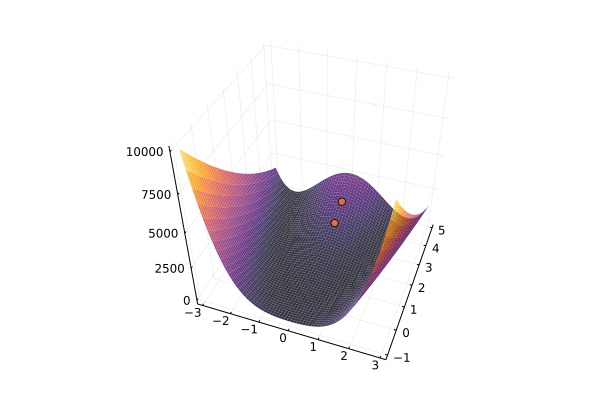Let's dive into the deep trenches of the loss function
with JITrench.jl.
]add https://github.com/abap34/JITrench.jl
julia> using JITrench
julia> f(x) = sin(x) + 1
f (generic function with 1 method)
julia> JITrench.@diff! f(x)
f′ (generic function with 1 method)
julia> f′(π)
-1.0julia> x = Scalar(2.5)
Scalar{Float64}(2.5)
julia> y = Scalar(3.5)
Scalar{Float64}(3.5)
julia> goldstain(x, y) = (1 + (x + y + 1)^2 * (19 - 14x + 3x^2 - 14y + 6x*y + 3y^2)) * (30 + (2x - 3y)^2 * (18 - 32x + 12x^2 + 48y - 36x*y + 27*y^2))
goldstain (generic function with 1 method)
julia> z = goldstain(x, y)
Scalar{Float64}(1.260939725e7)
julia> backward!(z)
julia> x.grad
-5.324409e6
julia> y.grad
3.3109701e7
julia> JITrench.plot_graph(z, to_file="example/visualize/goldstain.png")julia> A = AutoDiff.Tensor([1 2; 3 4; 5 6])
3×2 Tensor{Matrix{Int64}}:
1 2
3 4
5 6
julia> B = reshape(A, (2, 3))
2×3 Tensor{Matrix{Int64}}:
1 5 4
3 2 6
julia> C = B[1, :]
3×1 Tensor{Vector{Int64}}:
1
5
4
julia> y = sum(C)
Scalar{Int64}(10)
julia> backward!(y)
julia> A.grad
3×2 Matrix{Float64}:
1.0 0.0
0.0 1.0
1.0 0.0With the CuTensor type, you can perform calculations on the GPU as you would with Tensor.
julia> using JITrench
julia> using BenchmarkTools
julia> x = Tensor(rand(512, 512));
julia> W = Tensor(rand(512, 512));
julia> x_gpu = CuTensor(rand(512, 512));
julia> W_gpu = CuTensor(rand(512, 512));
julia> @benchmark x * W
BenchmarkTools.Trial: 7490 samples with 1 evaluation.
Range (min … max): 616.548 μs … 1.238 ms ┊ GC (min … max): 0.00% … 47.29%
Time (median): 649.301 μs ┊ GC (median): 0.00%
Time (mean ± σ): 665.530 μs ± 90.051 μs ┊ GC (mean ± σ): 2.36% ± 7.64%
▆█▆▂ ▁ ▁
▄▇████▇▆▃▃▁▁▁▄▃▁▁▁▁▃▁▁▃▁▁▁▁▁▁▁▁▁▁▁▁▁▁▁▁▁▁▁▁▁▁▁▁▁▁▁▁▁▁▁▁▆██▇▇ █
617 μs Histogram: log(frequency) by time 1.19 ms <
Memory estimate: 2.00 MiB, allocs estimate: 5.
julia> @benchmark x_gpu * W_gpu
BenchmarkTools.Trial: 10000 samples with 3 evaluations.
Range (min … max): 8.317 μs … 12.454 ms ┊ GC (min … max): 0.00% … 10.13%
Time (median): 38.716 μs ┊ GC (median): 0.00%
Time (mean ± σ): 38.481 μs ± 124.332 μs ┊ GC (mean ± σ): 0.33% ± 0.10%
▄ ▃▁▂ ▁ ▄█▆▃▄ ▂
█▅▄▅▁▁▃▁▁▁▁▃▁▁▁▁▁▁▁▁▁▁▁▁▁▁▁▃▁▁▁▁▁▁▁▁▁▁▁▁▁▁▁▁▄███▅▄▁▄█▇▆█████ █
8.32 μs Histogram: log(frequency) by time 40.6 μs <
Memory estimate: 704 bytes, allocs estimate: 31.rosenbrock(x₀, x₁) = 100 * (x₁ - x₀^2)^2 + (x₀ - 1)^2
x₀ = Scalar(0.0)
x₁ = Scalar(5.0)
lr = 1e-3
iters = 10000
for i in 1:iters
y = rosenbrock(x₀, x₁)
JITrench.AutoDiff.cleargrad!(x₀)
JITrench.AutoDiff.cleargrad!(x₁)
backward!(y)
x₀.values -= lr * x₀.grad
x₁.values -= lr * x₁.grad
endSee example/optimization/gradient_descent.jl for details.
JITrench.jl can also compute higher-order derivatives!
using JITrench
f(x) = x^4 - 2x^2
x = Scalar(2.0)
iters = 10
for i in 1:iters
y = f(x)
JITrench.AutoDiff.cleargrad!(x)
backward!(y, create_graph=true)
gx = x.grad
JITrench.AutoDiff.cleargrad!(gx)
backward!(gx)
gx2 = x.grad
x.values -= gx.values / gx2.values
endSee example/optimization/newton_method.jl for details.
using JITrench
using JITrench.NN
using Printf
N = 100
p = 1
n_iter = 20000
x = rand(N, p)
y = sin.(2π .* x) + (rand(N, p) / 1)
function model(x)
x = NN.Linear(out_dim=10)(x)
x = NN.functions.sigmoid.(x)
x = NN.Linear(out_dim=1)(x)
return NN.result(x)
end
params = NN.init(model, NN.Initializer((nothing, 1)))
optimizer = NN.SGD(params, 1e-1)
x = Tensor(x)
y = Tensor(y)
for iter in 1:n_iter
pred = NN.apply(model, x, params)
loss = NN.functions.mean_squared_error(y, pred)
NN.cleargrads!(params)
backward!(loss)
NN.optimize!(optimizer)
if (iter % 500 == 0)
@printf "[iters] %4i [loss] %.4f\n" iter loss.values
end
end
NN.save_weight(params, "weight")This is a simple example of training a sine curve on an MLP and saving the weights as 'weights.jtw'
Progress of the training:
The visualization code is available in 'example/NN/MLP.jl'.





